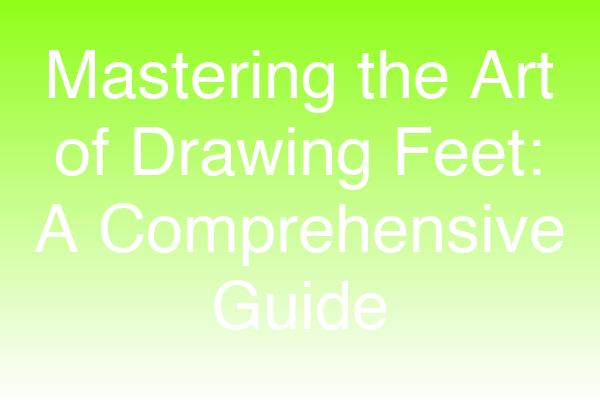
Categories: Art Techniques, Drawing Tips, Anatomy for Artists
Tags: how to draw feet, drawing feet tutorial, anatomy drawing, sketching feet, art techniques, drawing tips, figure drawing
How to Draw Feet: A Comprehensive Guide
Drawing feet can be one of the most challenging aspects of figure drawing for artists. Yet, mastering this skill is essential for creating realistic and dynamic figures. In this guide, we will explore various techniques, tips, and resources to help you learn how to draw feet with confidence and accuracy.
Why Drawing Feet is Important
Feet are often overlooked in the realm of drawing, but they play a crucial role in the overall balance and proportion of the human figure. Understanding how to depict feet accurately not only enhances your figure drawing but also improves your ability to convey movement and emotion in your art.
Understanding Foot Anatomy
Before diving into the techniques of how to draw feet, it's essential to understand the basic anatomy of the foot. The human foot consists of 26 bones, 33 joints, and numerous muscles and tendons. Here’s a simplified breakdown:
| Foot Component | Description |
|---|---|
| Phalanges | The bones of the toes (14 in total) |
| Metatarsals | The five long bones in the midfoot |
| Tarsals | The seven bones that make up the back part of the foot (including the heel) |
| Arch | The curved structure of the foot that supports weight |
Step-by-Step Guide on How to Draw Feet
Step 1: Basic Shapes
Start by breaking down the foot into basic shapes. Use simple geometric forms to outline the foot's structure. For instance:
- Toes: Draw small ovals or rectangles for each toe.
- Foot Arch: Use a curved line to represent the arch.
- Heel: Draw a larger oval or triangle to depict the heel.
Step 2: Proportions
Understanding proportions is key to drawing realistic feet. A common guideline is that the length of the foot is approximately 1/7th of the total height of the figure. Use this ratio to maintain proper proportions in your drawings.
Step 3: Adding Details
Once you have the basic shapes and proportions, start adding details:
- Toes: Define the shape and size of each toe. Remember that the big toe is usually the largest.
- Nails: Add toenails by drawing small curves at the tip of each toe.
- Skin Texture: Use light shading to indicate the contours of the foot and the arch.
Step 4: Practice Different Angles
Feet can be viewed from various angles. Practice drawing feet from the front, side, and back to gain a comprehensive understanding. Here are some angles to practice:
- Front View: Focus on the alignment of the toes and the width of the foot.
- Side View: Pay attention to the arch and the heel's height.
- Back View: Observe how the Achilles tendon and the heel appear.
Expert Tips for Drawing Feet
- Use Reference Photos: Study photographs of feet to understand their structure and nuances.
- Sketch from Life: Whenever possible, draw feet from real-life models to gain a better grasp of their form.
- Practice Gesture Drawing: Quick sketches of feet in motion can help you capture their dynamic nature.
"Drawing feet is not just about the shapes; it's about understanding the movement and weight distribution in the human body." - Jane Doe, Professional Artist
Common Mistakes to Avoid
- Ignoring Proportions: Always keep an eye on the overall proportions of the foot in relation to the body.
- Overlooking Details: Small details like the curvature of the toes and the arch can make a significant difference.
- Neglecting Shadows: Adding shadows can enhance the three-dimensionality of your drawing.
Resources for Further Learning
- Books: "Figure Drawing: Design and Invention" by Michael Hampton offers excellent insights into figure drawing, including feet.
- Online Courses: Websites like Skillshare and Udemy provide courses specifically focused on figure drawing and anatomy.
Conclusion
Learning how to draw feet is a vital skill for any artist looking to improve their figure drawing. By understanding foot anatomy, practicing different angles, and applying expert tips, you can create realistic and expressive feet in your artwork. Remember, practice makes perfect, so keep sketching!
Call-to-Action: Ready to take your drawing skills to the next level? Join our online art community for exclusive tutorials and feedback from fellow artists!
Social Media Snippet: Struggling with how to draw feet? Discover expert tips and techniques in our comprehensive guide! #ArtTips #DrawingFeet #FigureDrawing
Suggested Internal Links:
- Essential Drawing Techniques for Beginners
- Understanding Human Anatomy for Artists
- Top 10 Figure Drawing Resources
Suggested External Links:
FAQs
Q1: What are the best resources for learning how to draw feet?
A1: Books like "Figure Drawing: Design and Invention" and online courses on platforms like Skillshare are excellent resources.
Q2: How can I improve my foot drawing skills?
A2: Practice regularly, use reference images, and study the anatomy of the foot to enhance your skills.
Q3: What are common mistakes when drawing feet?
A3: Common mistakes include ignoring proportions, overlooking details, and neglecting shadows.
Q4: Should I draw feet from real life or photos?
A4: Both methods are beneficial. Drawing from life helps with understanding form, while photos are great for studying details.
Q5: How important is foot anatomy in figure drawing?
A5: Understanding foot anatomy is crucial for creating realistic and proportionate figures. It enhances the overall quality of your artwork.